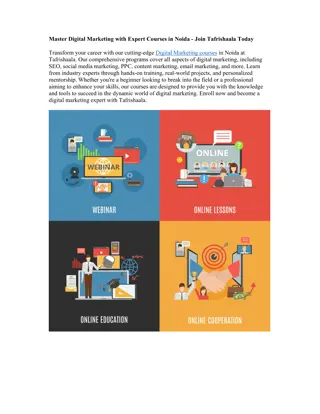Competitive Marketing Strategies: Gaining an Edge in Today's Marketplace
To succeed in today's competitive market, companies must excel in managing customer relationships and understanding their competitors. This involves competitor analysis, identifying key competitors, and developing strategies to create value for customers. By analyzing competitors' marketing approaches, products, prices, and promotions, companies can establish competitive advantages and enhance customer relationships. Learn about the importance of competitive marketing strategies and competitor analysis in this comprehensive overview.
- Competitive Marketing Strategies
- Customer Relationships
- Competitor Analysis
- Value Creation
- Market Competition
Download Presentation

Please find below an Image/Link to download the presentation.
The content on the website is provided AS IS for your information and personal use only. It may not be sold, licensed, or shared on other websites without obtaining consent from the author. Download presentation by click this link. If you encounter any issues during the download, it is possible that the publisher has removed the file from their server.
E N D
Presentation Transcript
Advertising Management and Public Relations Course Fourth year, English Program Week10, Lecture10 Dr/Sally Amer 15-4-2020
Chapter 18 Creating Competitive Advantage
Learning Objectives 1- Discuss the need to understand competitors as well as customers through competitor analysis. 2- Explain the fundamentals of competitive marketing strategies based on creating value for customers.
Overview - To win in today s marketplace, companies must become adept not only in managing products but also in managing customer relationships in the face of determined competition and a difficult marketing environment. Understanding customers is crucial, but it s not enough. Building profitable customer relationships and gaining competitive advantage require delivering more value and satisfaction to target customers than competitors do. In this chapter, we examine competitive marketing strategies how companies analyze their competitors and develop successful, customer value based strategies for engaging customers and building profitable customer relationships. The first step is competitor analysis, the process of identifying, assessing, and selecting key competitors. The second step is developing competitive marketing strategies that strongly position the company against competitors and give the company the strongest possible strategic advantage.
Competitor Analysis To plan effective marketing strategies, a company needs to find out all it can about its competitors. It must constantly compare its marketing strategies, products, prices, channels, and promotions with those of close competitors. In this way, the company can find areas of potential competitive advantage and disadvantage. So, competitor analysis involves first identifying and assessing competitors and then selecting which competitors to attack or avoid.
Steps in analyzing competitors 1- Identifying Competitors The company can define its competitors as other companies offering similar products and services to the same customers at similar prices. However, companies actually face a much wider range of competitors. The company might define its competitors as all firms with the same product or class of products. Even more broadly, competitors might include all companies making products that supply the same service. Finally, and still more broadly, competitors might include all companies that compete for the same consumer dollars.
1- Identifying Competitors (Cont.) Companies can identify their competitors from an industry point of view. They might see themselves as being in the oil industry, the pharmaceutical industry, or the beverage industry. Companies can also identify competitors from a market point of view. Here they define competitors as companies that are trying to satisfy the same customer need or build relationships with the same customer group. From an industry point of view, Google once defined its competitors as other search engine providers such as Yahoo! or Microsoft s Bing. Now, Google takes a broader view of serving market needs for online and mobile access to the digital world.
2- Assessing Competitors Marketing management now asks: - What are the competitors objectives? What does each seek in the marketplace? What is each competitor s strategy? What are various competitors strengths and weaknesses, and how will each react to actions the company might take? 2.1- Determining Competitors Objectives Each competitor has a mix of objectives. The company wants to know the relative importance that a competitor places on current profitability, market share growth, cash flow, technological leadership, service leadership, and other goals.
2- Assessing Competitors (Cont.) Knowing a competitor s mix of objectives reveals whether the competitor is satisfied with its current situation and how it might react to different competitive actions. For example, a company that pursues low-cost leadership will react much more strongly to a competitor s cost-reducing breakthrough than to the same competitor s increase in advertising. manufacturing
2- Assessing Competitors (Cont.) 2.2- Identifying Competitors Strategies The more that one firm s strategy resembles another firm s strategy, the more the two firms compete. In most industries, the competitors can be sorted into groups that pursue different strategies. A strategic group is a group of firms in an industry following the same or a similar strategy in a given target market .
Strategic groups: Brands sometimes cross strategic groups. Ford sells a limited-production, ultra-high performance, $400,000 ford GT road car that showcases its innovation and technological prowess. For example, in the auto industry, Ford and Toyota belong to the same strategic group. Each produces a full line of low- to medium price mainstream vehicles supported by great warranties and broad dealership networks. BMW, Audi, and Mercedes belong to a different strategic group that focuses more on luxury performance. In contrast, Ferrari, Lamborghini, and McLaren produce narrower lines of very high-performance, premium-priced sports cars through a highly exclusive distribution and support network.
2- Assessing Competitors (Cont.) The company needs to look at all the dimensions that identify strategic groups within the industry. It must understand how each competitor delivers value to its customers. It needs to know each competitor s product quality, features, and mix; customer services; pricing policy; distribution coverage; sales force strategy; and advertising, sales promotion, and online and social media programs. And it must study the details of each competitor s research and development (R&D), manufacturing, purchasing, financial, and other strategies.
2- Assessing Competitors (Cont.) 2.3- Assessing Competitors Strengths and Weaknesses Marketers need to carefully assess each competitor s strengths and weaknesses to answer a critical question: What can our competitors do? As a first step, companies can gather data on each competitor s goals, strategies, and performance over the past few years. Companies normally learn about their competitors strengths and weaknesses through secondary data, personal experience, and word of mouth. They can also conduct primary marketing research with customers, suppliers, and dealers. They can check competitors online and social media sites
Benchmarking Or they can try benchmarking themselves against other firms, comparing the company s products and processes to those of competitors or leading firms in other industries to identify best practices and find ways to improve quality and performance. Benchmarking is a powerful tool for increasing a company s competitiveness.
2- Assessing Competitors (Cont.) 2.4- Estimating Competitors Reactions Next, the company wants to know: What will our competitors do? They also suggest its likely reactions to company moves, such as price cuts, promotion increases, or new product introductions. In addition, each competitor has a certain philosophy of doing business, a certain internal culture and guiding beliefs. Each competitor reacts differently. - Some do not react quickly or strongly to a competitor s move or they may lack the funds to react. - Some competitors react only to certain types of moves and not to others. - Other competitors react swiftly and strongly to any action. Knowing how major competitors react gives the company clues on how best to attack competitors or how best to defend its current positions.
3- Selecting Competitors to Attack and Avoid Management now must decide which competitors to compete against most vigorously. 3.1- Strong or Weak Competitors A company can focus on one of several classes of competitors. Most companies prefer to compete against weak competitors. This requires fewer resources and less time. But in the process, the firm may gain little. You could argue that a firm also should compete with strong competitors to sharpen its abilities. But even strong competitors have some weaknesses, and succeeding against them often provides greater returns
Customer Value Analysis A useful tool for assessing competitor strengths and weaknesses is customer value analysis. The aim of customer value analysis is to determine the benefits that target customers value and how customers rate the relative value of various competitors offers. It conducting a customer value analysis, the company first identifies the major attributes that customers value and the importance customers place on these attributes. Next, it assesses its performance against competitors on those valued attributes. The key to gaining competitive advantage is to examine how a company s offer compares to that of its major competitors in each customer segment.
3- Selecting Competitors to Attack and Avoid (Cont.) 3.2- Good or Bad Competitors A company really needs and benefits from competitors. The existence of competitors results in several strategic benefits. Competitors may share the costs of market and product development and help legitimize new technologies. Finally, competitors may help increase total demand. However, a company may not view all its competitors as beneficial. An industry often contains good competitors and bad competitors. Good competitors play by the rules of the industry. Bad competitors, in contrast, break the rules. They try to buy share rather than earn it, take large risks, and play by their own rules.
Good and bad competitors: Rather than spelling trouble for Amazon s Kindle, Apple s iPad introduction created a surge in tablet demand that benefited not only Amazon but other tablet competitors as well.
3- Selecting Competitors to Attack and Avoid (Cont.) 3.3- Finding Uncontested Market Spaces Rather than competing head-to-head with established competitors, many companies seek out unoccupied positions in uncontested market spaces. They try to create products and services for which there are no direct competitors. Called a blue ocean strategy, the goal is to make competition irrelevant. Companies have long engaged competition in search of profitable growth. They have fought for competitive advantage, battled over market share, and struggled for differentiation. Yet in today s overcrowded industries, competing head-on results in nothing but a bloody red ocean of rivals fighting over a shrinking profit pool. . in head-to-head
Tomorrows leading companies will succeed not by battling competitors but by creating blue oceans of uncontested market space. Such strategic moves termed value innovation create powerful leaps in value for both the firm and its buyers, creating all-new demand and rendering rivals obsolete. By creating and capturing blue oceans, companies can largely take rivals out of the picture























